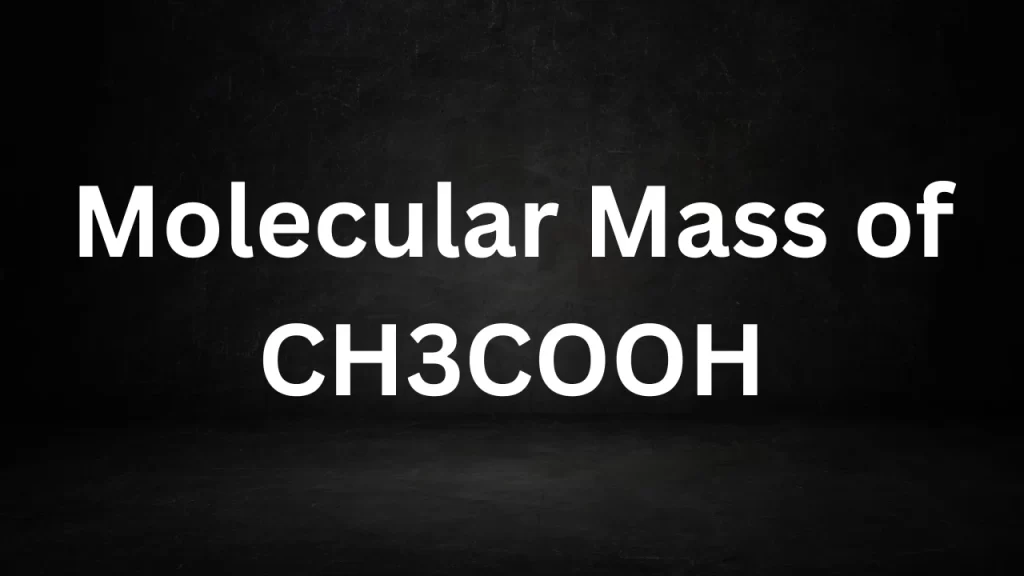Molecular Mass of CH3COOH
Molecular Mass of CH3COOH: Chemistry is a science that unveils the intricacies of the universe at the molecular level. A fundamental concept in this realm is molecular mass, also known as molecular weight or molar mass.
It plays a crucial role in understanding the composition and behavior of chemical compounds. In this article, we’ll explore the molecular mass of a familiar substance: acetic acid, represented by the chemical formula CH3COOH.

Molecular Mass of CH3COOH
Acetic Acid (CH3COOH): A Household Chemical with Widespread Utility
Acetic acid, commonly known as vinegar when diluted in water, is a simple organic compound with a distinctive pungent odor and a wide range of applications. It is a crucial component in the food industry for flavoring and preserving, and it has uses in the production of various chemicals, textiles, and plastics.
Calculating the Molecular Mass of CH3COOH
The molecular mass of a compound is determined by adding up the atomic masses of all the atoms in one molecule of that compound. In the case of acetic acid (CH3COOH), we must consider the atomic masses of its constituent elements:
- Carbon (C): The atomic mass of carbon is approximately 12.01 grams/mole (g/mol).
- Hydrogen (H): Hydrogen has an atomic mass of approximately 1.01 g/mol.
- Oxygen (O): The atomic mass of oxygen is around 16.00 g/mol.
Now, let’s perform the calculations:
Molecular Mass of CH3COOH = (Atomic Mass of C) + (2 * Atomic Mass of H) + (2 * Atomic Mass of O)
Molecular Mass of CH3COOH = (12.01 g/mol) + (2 * 1.01 g/mol) + (2 * 16.00 g/mol)
Molecular Mass of CH3COOH = 12.01 g/mol + 2.02 g/mol + 32.00 g/mol
Molecular Mass of CH3COOH ≈ 44.03 grams/mole
Thus, the molecular mass of acetic acid (CH3COOH) is approximately 44.03 grams per mole.
Significance of Molecular Mass
Understanding the molecular mass of a compound is essential in various scientific disciplines and industries. It is fundamental for accurate calculations in chemistry, including stoichiometry and chemical reactions. Molecular mass is used to determine the composition, concentration, and behavior of substances in a variety of applications.
Applications of Acetic Acid (CH3COOH)
Acetic acid finds wide-ranging applications, including:
- Food Industry: It is used as a food preservative and flavor enhancer.
- Chemical Industry: It serves as a precursor for the production of various chemicals, including plastics.
- Pharmaceuticals: It is used in the manufacture of certain medications.
- Textiles: It plays a role in dyeing and finishing textiles.
- Laboratory: It is a common reagent for chemical experiments.
Conclusion
In the captivating realm of chemistry, comprehending the molecular mass of compounds such as acetic acid (CH3COOH) is fundamental. It provides insights into the composition and behavior of substances, enabling precise calculations in chemical reactions and various industrial processes. With a molecular mass of approximately 44.03 g/mol, acetic acid is not only a household staple but also a versatile chemical with a profound impact on both daily life and scientific endeavors. Its ubiquitous presence highlights the significance of chemistry in shaping the world around us.
Read More
- Molecular Weight of kmno4
- Molecular Weight of CaCO3
- Molecular Mass Of CaCO3
- Molecular Mass Of Sulphur
- Equivalent Weight Of Hcl
Frequently Asked Questions (FAQs) mol Mass of CH3COOH
1. What is the molecular mass of CH3COOH?
The molecular mass of acetic acid (CH3COOH) is approximately 44.03 grams per mole (g/mol).
2. How is the mol mass of CH3COOH calculated?
To calculate the mol mass of CH3COOH, you add up the atomic masses of all the atoms in one molecule of CH3COOH:
- Carbon (C): Atomic mass ≈ 12.01 g/mol
- Hydrogen (H): Atomic mass ≈ 1.01 g/mol
- Oxygen (O): Atomic mass ≈ 16.00 g/mol
The calculation is as follows: mol Mass of CH3COOH = (Atomic Mass of C) + (2 * Atomic Mass of H) + (2 * Atomic Mass of O) mol Mass of CH3COOH ≈ 12.01 g/mol + 2.02 g/mol + 32.00 g/mol ≈ 44.03 g/mol
3. Why is it important to know the mol mass of CH3COOH?
Understanding the mol mass of CH3COOH is crucial in various scientific disciplines, particularly in chemistry. It is fundamental for accurate calculations in chemical reactions, stoichiometry, and determining the concentration of solutions. Molecular mass provides insights into the composition and behavior of substances.
4. What are some common uses of CH3COOH in daily life and industry?
Acetic acid (CH3COOH) has diverse applications, including:
- Food industry: It’s used in vinegar for flavoring and preservation.
- Chemical industry: It serves as a precursor for the production of various chemicals and plastics.
- Pharmaceuticals: It’s used in the manufacture of certain medications.
- Textiles: It’s involved in dyeing and finishing textiles.
- Laboratory: It’s a common reagent for chemical experiments.
5. Is CH3COOH safe to handle?
Acetic acid, in its diluted form (vinegar), is generally safe for common household use. However, concentrated acetic acid can be corrosive and should be handled with care, including wearing appropriate protective equipment. Safety precautions should be taken when working with concentrated acetic acid in laboratory or industrial settings.